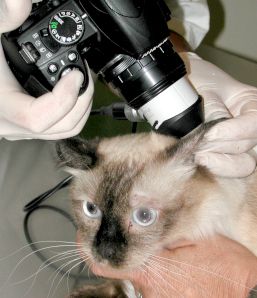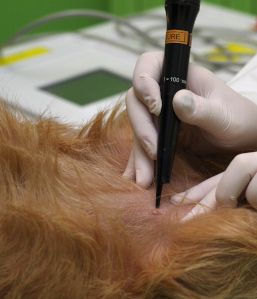For the clients
Dermatology
Dermatologic diseases in dogs and cats are numerous, and many of them present with similar clinical signs. Only a thorough examination by an experienced dermatologist can identify the subtle differences that allow for a correct diagnosis or the presence of an underlying systemic disease.
At the Studio Dermatologico Veterinario you will find the expertise and diagnostic equipment necessary for the optimal solution and management of your pet’s skin disease.

Diagnostic procedures:
During the dermatologic examination, routine procedures such as microscopic hair and earwax examinations and skin and ear cytology are performed.
Where the dermatologist deems appropriate, further specific examinations and treatments can be made:
- Bacteriological and mycological culture examinations and antibiotic susceptibility testing
- Allergy testing
- Skin biopsies and dermatopathological examinations
- Viodeotoscopies
- Dermoscopy
- Fluorescence Biomodulation
- CO2 laser vaporization and surgery
For some of these tests, the result will be announced during the visit; for others, it will be necessary to wait for the results from the testing laboratory.
It is also recommended that your pet be brought fasting in case of blood sampling or if procedures requiring sedation are to be performed especially skin biopsies, videotoscopies and CO2 laser ablation.
Tips for keeping your dog and cat’s skin healthy
Apply effective protection against parasites
A number of insecticidal products are currently available that are useful for prophylaxis and treatment of flea infestations in dogs and cats.
They can be either applied to the skin, usually as a spot on but also in the form of a spray, collar or administered orally.
Often both topical products and those given orally are also effective for other skin parasites that cause skin diseases such as mites and ticks, and sometimes for internal parasites as well. It is important to remember that pyrethroids, products used in dogs for protective action against mosquitoes and sandflies (Leihsmania’s vectors) are very toxic to cats!
Ask your veterinarian the most appropriate antiparasitic for your dog or cat.
Maintaining a balanced diet
Nutritional needs vary according to the size of the dog, the type of work it does, and its life stages (e.g., pregnancy, lactation).
If you have the time to cook you can contact a nutritionist who can formulate a balanced diet, otherwise it is advisable to use a commercial diet suitable for your pet.
Do not frequently change the type and formulation of the diet especially if you suspect that your dog or cat has a food intolerance. This may limit the choice of protein sources to be used for proper food testing in the future.
Frequently asked questions
If the dog does not have dermatological problems, it is not necessary to wash him often, and the type of shampoo and frequency is determined on a case-by-case basis, depending on the owner’s needs and the dog’s lifestyle (at home or in the garden).
In contrast, for a dog with a dermatologic disease, shampoo therapy becomes a fundamental part of the treatment and, in the case of superficial pyoderma, may become the sole therapy to be carried out twice a week. The shampoo should be dog-specific, and the type of shampoo, as well as the frequency of application, should be determined by the veterinary doctor according to the skin problem.
In dogs and cats, hair is gradually lost and replaced by growing hair, especially in the summer months. This is not a medical problem and is controlled by frequent brushing of the coat.
On the other hand, the appearance of patches of hairless skin or a thinning of the hair that leaves a glimpse of the underlying skin or even the failure of the hair to regrow after it has been cut are signs of dermatological problems. In all these cases it is necessary to rule out the presence of a dermatologic or endocrine disease (e.g., hypothyroidism).
A proper intake of essential fatty acids omega 3 (alpha linolenic acid) and omega 6 (linoleic acid) along with antioxidants (e.g., vit.E), is essential for healthy skin and coat. These nutritional elements have important roles in the structure and function of the body’s cells and especially in the health of the skin and coat.
An excellent source of omega 3 is flaxseed (short-chain omega 3), while fish, and especially oily fish and salmon, provide long-chain omega 3. Omega 6, on the other hand, is found in plant products, for example, corn or sunflower oil.




